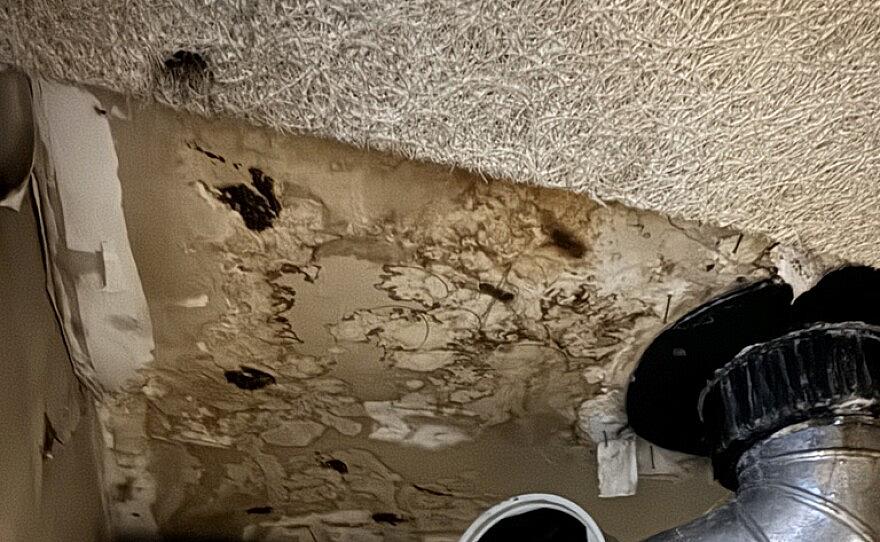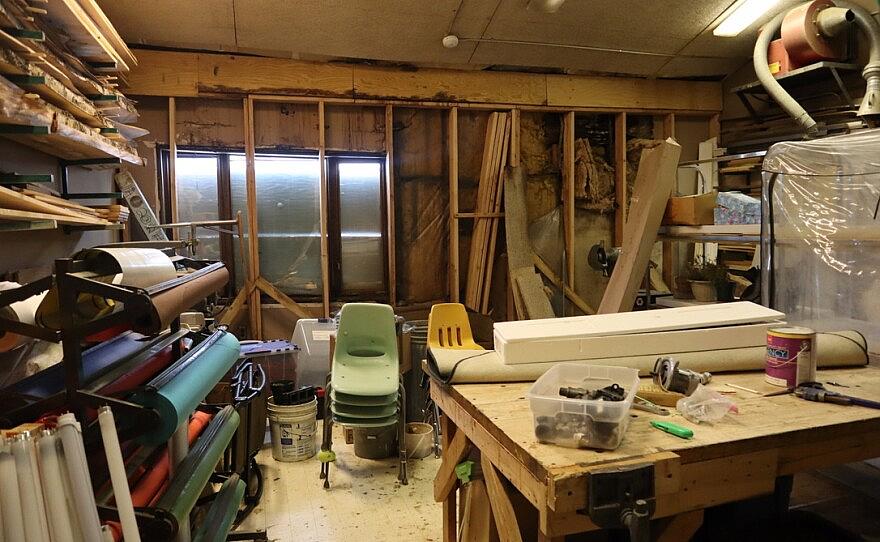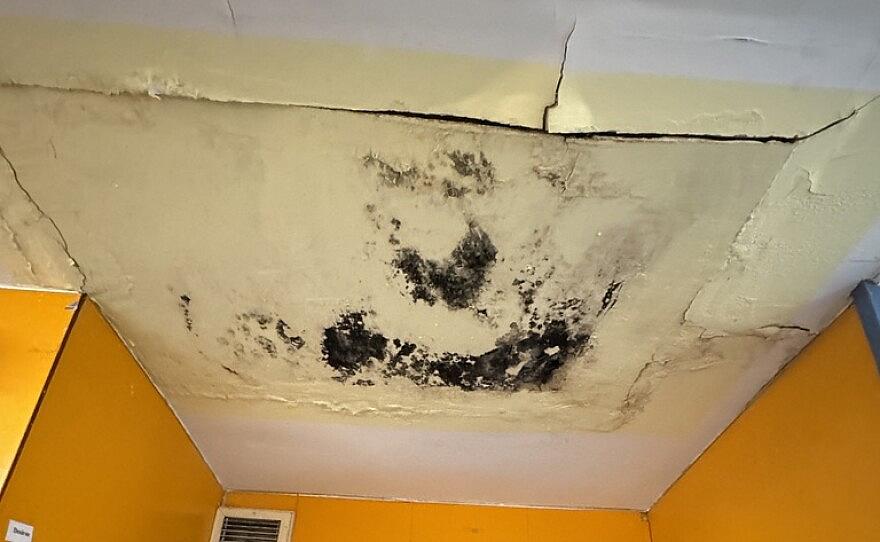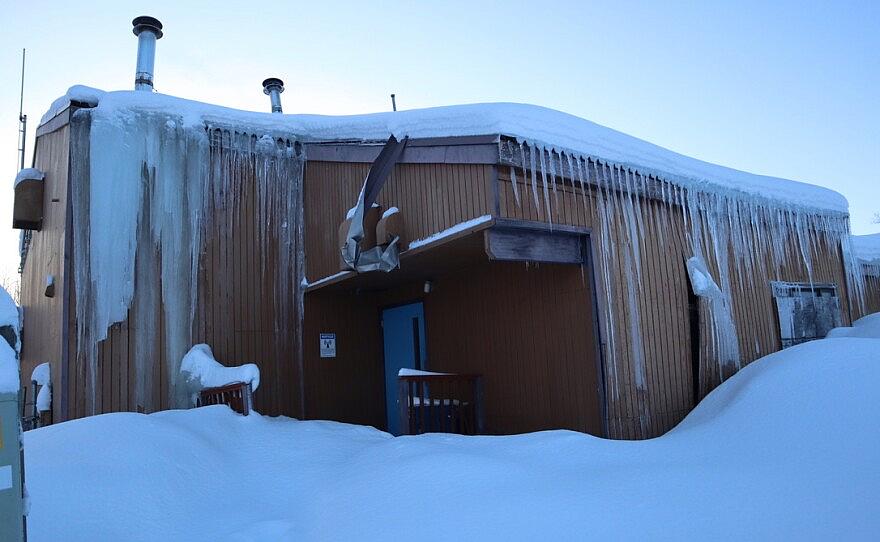Decades of lacking investment means rural Alaska’s schools now face public health and safety crises
The story was originally published in KYUK with support from our 2024 National Fellowship.

Mold covers the ceiling of the furnace room in Sleetmute's school.
Emily Schwing / KYUK
AUDIO TRANSCRIPT:
EMILY SCHWING: Every morning, before kids in Sleetmute head to class, Angela Hayden leads them in the Pledge of Allegiance. For Hayden this is a normal part of the day, but so is working inside a building that’s falling down around her.
ANGELA HAYDEN: The roof was leaking when I first started teaching here 17 years ago.
EMILY SCHWING: Hayden is the lead teacher and principal in Sleetmute, where there are no roads or shopping malls and internet and phone service are spotty. Fewer than 100 people live here.
ANGELA HAYDEN: I figured coming to a remote place in Alaska, I'm probably going to be more than just a teacher. And that's proven to be true. You have to have a lot of knowledge of so many different things just to survive and live out here.
EMILY SCHWING: Building maintenance is one of those things. Teachers and staff have been trying to prop up the sagging roof in Sleetmute’s school for years.
According to the state fire marshal, there is no mechanism to condemn a building in Alaska, but that’s exactly what an architect recommended here in 2021. There’s a very real risk that the back portion of Sleetmute’s school could collapse, so the school district closed the woodshop, the boys' bathroom next door, and the gym down the hall.

Damage to the woodshop in Sleetmute's school.
Now, 25 students and staff share a single bathroom, and they’re confined to three classrooms and a main atrium lined with portraits of the community's Yup'ik and Athabascan Elders.

Students and teachers at Sleetmute's school all share a bathroom.
Emily Schwing / KYUK
But even here, they can’t escape a host of public health and safety risks. Sheree Smith has been teaching in Sleetmute for over 12 years. Last fall, a bat flew into her classroom.
SHEREE SMITH: And then we went to get a tennis racket out of the gym and came out into the hallway, and I smacked it down with a tennis racket and killed it.
EMILY SCHWING: Smith told me a whole bunch of bats live above the gym. So I put on a mask and climbed a ladder up to a little closet that holds a loud hot water heater.
EMILY SCHWING: You can see there’s animal waste all over the floor. It looks like somebody’s been living in the insulation in the ceiling. And then way in the back, you can see that the ceiling is moldy.

Mold above the door to the gym at Sleetmute's school.
Emily Schwing / KYUK
EMILY SCHWING: Madeline Aguillard is the superintendent of the Kuspuk School District, which includes Sleetmute. She says it's unrealistic for school districts and the state to learn in these conditions.
MADELINE AGUILLARD: They're not conducive for high expectations. They're not conducive for academic achievement. They're not conducive for athletic achievement.
EMILY SCHWING: These building conditions also pose real health risks. Long term exposure to black mold can irritate lungs, exacerbate respiratory conditions, and cause chronic fatigue, skin rashes, and neurological problems. Airborne fungal spores from bat feces also irritate lungs and can cause blindness.
Andrea John has three kids enrolled at the Sleetmute school. Sometimes, she says, they come home sick.
ANDREA JOHN: Like my older son, he complains about headaches.
EMILY SCHWING: How often?
ANDREA JOHN: Not as much as before, but he did, like, last year or year before. He was complaining about headaches pretty much every day. Okay. So it could be, you know, the mold or whatever.
EMILY SCHWING: Federal agencies and health care providers have long documented higher rates of health disparities among Alaska Natives compared to the general population. And most of the students in the state’s rural school districts are Indigenous. But there’s virtually no public data available to explain the potential health consequences for kids, teachers, and staff who spend their days inside these buildings. Alaska’s public health department and regional health care providers cited privacy concerns when they declined to provide information about some of the illnesses documented in Alaska’s rural villages. Even if data were available, it would be complicated by known sanitation and housing challenges in some remote communities.
John says she knows the school isn’t safe, but she’s not willing to keep her kids from their education.
ANDREA JOHN: Even though we have concerns for our kids, you know, we got no choice. And we value the education, and we need education to do things in life.
EMILY SCHWING: Alaska’s rural school districts rely almost entirely on the state for funding. The communities they serve don’t have local governments that can levy taxes to help pay for schools. And in Sleetmute, the state department of education owns the building. State law says the agency is responsible for major construction projects.
Alaska Education Commissioner Deena Bishop acknowledges the public health concern, but says her agency isn’t solely responsible for fixing the problem.
DEENA BISHOP: If something's happening in the school, it's most likely happening in other buildings in the community. So, you know, like, it is a collective Alaskan issue that we'd be happy to have a seat at the table to discuss.
EMILY SCHWING: Bishop says some problems in rural schools have been left unchecked for years.
DEENA BISHOP: Probably from the moment that those buildings were built, now, the investments haven't kept up with the wear and tear on those facilities. So certainly as they are reported and go through the process, we do work to take care of those and mitigate any kind of dangerous conditions.
EMILY SCHWING: The school district has asked the state for money to help fix the roof in Sleetmute 19 times. Architectural and engineering reports submitted with those applications highlight the public health and safety risks to anyone who uses the school. It’s unclear why it was left to leak for nearly two decades, but Andrea John says she thinks it’s because it’s easy for the state to forget communities like hers.

Icicles hang off the back of Sleetmute's school.
Emily Schwing / KYUK
ANDREA JOHN: They’re choosing to look the other way and say 'the hell with us.'
EMILY SCHWING: Last summer, the legislature finally did sign off on funding for a new roof in Sleetmute, but it’s not enough money to address other problems that have resulted from the decades of leaking. John says the solution has simply been out of reach for too long.
ANDREA JOHN: They should have helped us when we needed help in the beginning, not wait 20 years. Those city people, they wouldn’t wait 20 years to get help, they would do it right now, now, now, now, right this minute instead of dragging it on for ages. They wouldn’t let their kids go to school here.
EMILY SCHWING: In Sleetmute, I’m Emily Schwing.

